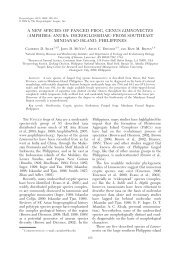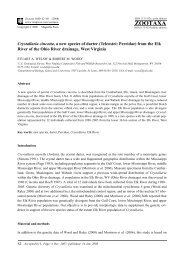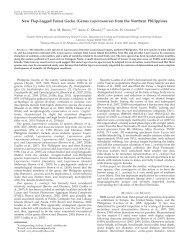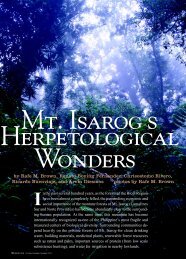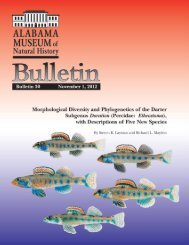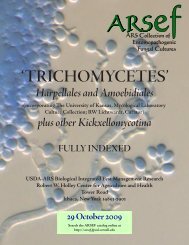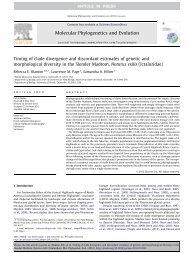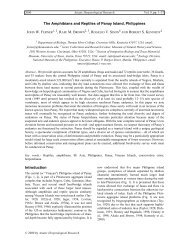a new species of scincid lizard (genus sphenomorphus) - BioOne
a new species of scincid lizard (genus sphenomorphus) - BioOne
a new species of scincid lizard (genus sphenomorphus) - BioOne
You also want an ePaper? Increase the reach of your titles
YUMPU automatically turns print PDFs into web optimized ePapers that Google loves.
Herpetologica, 66(1), 2010, 67–79A NEW SPECIES OF SCINCID LIZARD (GENUS SPHENOMORPHUS)FROM PALAWAN ISLAND, PHILIPPINESCHARLES W. LINKEM 1,3 ,ARVIN C. DIESMOS 2 , AND RAFE M. BROWN 11 University <strong>of</strong> Kansas Natural History Museum and Biodiversity Research Center and Department <strong>of</strong> Ecology andEvolutionary Biology, 1345 Jayhawk Boulevard, Lawrence, KS 66045, USA2 Herpetology Section, Zoology Division, National Museum <strong>of</strong> the Philippines, Padre Burgos Avenue, Ermita 1000,Manila, PhilippinesABSTRACT: A <strong>new</strong> <strong>species</strong> <strong>of</strong> medium-sized Sphenomorphus is described from the biogeographicallyenigmatic island <strong>of</strong> Palawan in the western Philippines. This <strong>species</strong> represents only the third skink in the <strong>genus</strong>Sphenomorphus found on Palawan Island. The <strong>new</strong> <strong>species</strong> is compared with other Sphenomorphus found onPalawan and with phenotypically similar <strong>species</strong> in the <strong>genus</strong> from throughout its range. To aid in futureidentification <strong>of</strong> Sphenomorphus specimens from Palawan, we provide a key to the <strong>species</strong> from this island.Key words: Borneo; New <strong>species</strong>; Palawan; Philippines; Scincidae; SphenomorphusE 2010 by The Herpetologists’ League, Inc. THE GENUS Sphenomorphus Fitzinger 1843is a large, polyphyletic group (Myers andDonnelly, 1991; Reeder, 2003; Skinner, 2007)composed <strong>of</strong> a variety <strong>of</strong> morphological types.There are at least 145 <strong>species</strong> (Uetz andHallermann 2009) currently described, withall but three <strong>of</strong> these <strong>species</strong> occurring in Asiaand the Pacific Islands. Many attempts havebeen made to divide this group into othergenera or subgroups based on external andinternal morphological characters (Boulenger,1887; Brown and Alcala, 1980; Ferner et al.,1997; Greer and Parker, 1967a, 1974; Smith,1937; Taylor, 1922c). Some <strong>of</strong> these groupingshave been subsequently rejected (e.g., thegenera Insulasaurus, Otosaurus, andParatosaurussynonomized with Sphenomorphus,fide Greer and Parker, 1967b,c) based onevidence that the characters used to definethose groups where homoplastic. Althoughmost <strong>of</strong> the subgroups <strong>of</strong> Sphenomorphus lacka phylogenetic validation, they are nonethelessuseful in distinguishing <strong>new</strong> <strong>species</strong> fromphenotypically similar <strong>species</strong>.The most recent comprehensive examination<strong>of</strong> Sphenomorphus in the Philippinesenumerated 23 <strong>species</strong> (Brown and Alcala,1980). Expanding on the previous work <strong>of</strong>Taylor (1922a,b,c, 1923, 1925), Brown andAlcala synonymized several <strong>species</strong> recognizedby Taylor and described four <strong>new</strong><strong>species</strong>. In addition, they followed Greer andParker (1967b,c, 1974) in synonymizing the3 CORRESPONDENCE: e-mail, cwlinkem@ku.edu67genera Insulasaurus, Otosaurus, Parotosaurus,and some members <strong>of</strong> Lygosoma withSphenomorphus. Since Brown and Alcala’sreview, three <strong>new</strong> <strong>species</strong> have been described(Brown, 1995; Brown et al., 1995,1999), and one <strong>species</strong> has been moved into a<strong>new</strong> <strong>genus</strong>, Parvoscincus palawanensis (Ferneret al., 1997). Those studies brought thetotal number <strong>of</strong> recognized <strong>species</strong> <strong>of</strong> Sphenomorphusin the Philippines to 25.Brown and Alcala (1980) divided PhilippineSphenomorphus into six phenetic groups.These groupings were based on size atmaturity, extent <strong>of</strong> limb and digit development,and numbers <strong>of</strong> midbody scale rows, subdigitallamellae, and paravertebral scale rows. Brownand Alcala’s <strong>species</strong> groups are based solely onoverall phenotypic similarity within Philippine<strong>species</strong> and may not correspond to phylogeneticallydefined clades. However, currently,they are our only guide for Philippine Sphenomorphussystematics and, as such, are usefulfor <strong>species</strong> comparisons.Palawan Island, in the western region <strong>of</strong> thePhilippines, has two recognized <strong>species</strong> <strong>of</strong>Sphenomorphus: S. victoria and S. wrighti.These <strong>species</strong> are found in groups III and IV,respectively (Brown and Alcala, 1980). Also onPalawan Island is the <strong>species</strong> Parvoscincuspalawanensis, which is similar to Sphenomorphusand may be closely related to the <strong>genus</strong>,but is very different from the other <strong>species</strong> onthe island due to its reduced size, lack <strong>of</strong>prefrontals, and scaled-over ear (Ferner et al.,1997).
68 HERPETOLOGICA [Vol. 66, No. 1Past zoogeographic work has suggested astrong faunal relationship between Palawanand Borneo as a result <strong>of</strong> a possible landconnection during the last Pleistocene glacialmaximum (Heaney, 1986; Huxley, 1868; butsee Brown and Diesmos, 2009; Brown andGuttman, 2002). Huxley (1868) modified thenorthwestern portion <strong>of</strong> Wallace’s zoogeographicbarrier, separating the Philippines intotwo zoogeographic zones and placing PalawanIsland as part <strong>of</strong> the Sunda Shelf/Asian fauna.Brown and Guttman (2002) and McGuire andKiew (2001) provided some <strong>of</strong> the firstphylogenetic evidence suggesting that some<strong>of</strong> Palawan’s endemic amphibians and reptilesmay be more closely related to the oceanicportions <strong>of</strong> the Philippines, to the exclusion <strong>of</strong>the Sunda Shelf. With no clear distinction inthe literature on the affinity <strong>of</strong> Palawan fauna,it is critical to compare it with the fauna <strong>of</strong> bothBorneo and the oceanic Philippines.In this paper, we describe a <strong>new</strong> <strong>species</strong> <strong>of</strong>lygosomine skink from Palawan Island, foundduring a collaborative survey between ConservationInternational Philippines and the University<strong>of</strong> Kansas Biodiversity Institute. Weassign this <strong>new</strong> <strong>species</strong> to the <strong>genus</strong> Sphenomorphusbased on the presence <strong>of</strong> enlargedmedial precloacal scales that overlap lateralprecloacal scales; supradigital scales double ortriple and imbricate; hemipenes bifurcate; lack<strong>of</strong> undivided transparent scale in lower eyelid;four pentadactyl limbs; and fewer than 30subdigital lamellae on Toe IV (Lim, 1998; Sheaand Greer, 2002; Taylor, 1963). We furtherplace this <strong>species</strong> in the Sphenomorphusvariegatus Group (Greer and Parker, 1967a),which includes Philippine Group IV (Brownand Alcala, 1980), based on the followingexternal and internal characters: lack <strong>of</strong> postorbitalbone; supratemporal fenestra very small;no anterior projection <strong>of</strong> the ectopterygoidprocess; well developed digits and limbs whichoverlap when adpressed; and enlarged nuchalslacking. The Sphenomorphus variegatus Groupis spread throughout Asia and Southeast Asia,consisting <strong>of</strong> 37 <strong>species</strong> that are phenotypicallysimilar. We compare the <strong>new</strong> <strong>species</strong> to <strong>species</strong>in the S. variegatus Group as well as to <strong>species</strong>in geographic proximity to Palawan Island,Borneo, and the Philippines. We show that the<strong>new</strong> <strong>species</strong> differs from its congeners in thecombination <strong>of</strong> size at maturity, scale morphology,and coloration.MATERIALS AND METHODSA research team supported by ConservationInternational Philippines and the University<strong>of</strong> Kansas Biodiversity Research Center madecollections <strong>of</strong> animals in forested areas <strong>of</strong> Mt.Mantalingahan on Palawan Island during July2007. These researchers used multiple techniquesto collect the animals including captureby hand, pitfall traps, and snap traps. Theyfixed all specimens in 10% buffered formalinto preserve them, and after a few months thespecimens were transferred to 70% ethanol.Senior author CWL determined sex bygonadal inspection and performed measurementsusing Mitutoyo digital calipers to thenearest 0.01 mm.Measurements used are snout–vent length(SVL) measured from the tip <strong>of</strong> the snout tothe cloacal opening; tail length (TL) measuredfrom the cloacal opening to the tip <strong>of</strong> the tail;axilla–groin distance (AGD) measured fromthe posterior margin <strong>of</strong> the forelimb insertionto the anterior margin <strong>of</strong> the hind limbinsertion; head length (HL) measured fromthe anterior margin <strong>of</strong> the ear opening to thetip <strong>of</strong> the snout; head width (HW) measuredat the widest part <strong>of</strong> the temporal region;snout–forelimb length (SFL) measured fromthe anterior margin <strong>of</strong> the forelimb insertionto the tip <strong>of</strong> the snout; internarial distance(IND) measured between the dorsal margin<strong>of</strong> the two nares; rostrum length (RostL)measured from the anterior margin <strong>of</strong> the eyeto the tip <strong>of</strong> the snout; interorbital distance(IOD) width <strong>of</strong> orbital region at mid orbital;eye diameter (ED) measured at widest point;ear diameter (EarD) measured at widestpoint; forelimb length (FLL) measured frombase <strong>of</strong> palm to elbow; hind limb length(HLL) measured from knee to ankle.Scales were counted by CWL on the rightside <strong>of</strong> the body with a dissecting microscope.Scale counts include number <strong>of</strong> paravertebralscales (PVSR), dorsoventral scales between theparietals and the scales at the cloaca on thedorsal side; number <strong>of</strong> midbody scale rows(MBSR), scale rows around the middle <strong>of</strong> thebody; number <strong>of</strong> subdigital lamellae on Toe IV(SDL); number <strong>of</strong> supralabials (SL); number <strong>of</strong>
March 2010] HERPETOLOGICA 69FIG. 1.—Dorsal aspect <strong>of</strong> (A) Sphenomorphus traanorumholotype (PNM 9562), (B) S. victoria (KU309443), and (C) S. wrighti (KU 311439) at equal scale.Sphenomorphus traanorum has easily recognizable shorteraxilla–groin distance and lack <strong>of</strong> dorsovertebral spots.Scale bar 5 10 mm.infralabials (IL); number <strong>of</strong> anterior loreals (L);and number <strong>of</strong> enlarged supraoculars (SO).Institution abbreviations for specimensexamined in this study follow Leviton et al.(1985), with the addition <strong>of</strong> the following fieldcollector abbreviations: BSI-FS, Sulawesi BioticSurveys and Inventories Field Series;ELR, E. L. Rico; and DSB, D. S. Belete.For the recognition <strong>of</strong> the <strong>new</strong> <strong>species</strong>, weadopt the General Lineage Concept <strong>of</strong> deQuieroz (1998, 1999) as the natural extension<strong>of</strong> the evolutionary <strong>species</strong> concept (Wiley,1978). Application <strong>of</strong> lineage based <strong>species</strong>concepts to island systems is straightforwardbecause <strong>of</strong> the known history <strong>of</strong> isolation <strong>of</strong>island populations (Brown and Diesmos,2002; Brown and Guttman, 2002). We consideras <strong>new</strong> <strong>species</strong> morphologically diagnosableforms for which the hypothesis <strong>of</strong>conspecificity can be rejected.SPECIES ACCOUNTSphenomorphus traanorum sp. nov.(Figs. 1–3)Holotype.—PNM 9640 (formerly KU311442: DSB 4816): Female: Philippines,FIG. 2.—Lateral and dorsal view <strong>of</strong> head <strong>of</strong> holotype <strong>of</strong>Sphenomorphus traanorum showing scalation characteristics.Scale bar 5 5 mm.Palawan Island, Palawan Province, Municipality<strong>of</strong> Rizal, 2.5 km W and 0.7 km S Mt.Mantalingahan peak, 1550 m (8.8126u N,117.6587u E). Collected 24 June 2007 by D.S. Balete.Paratypes.—KU 311423 (ELR1553), PNM9641 (KU 311424, ELR 1569): Philippines,Palawan Island, Palawan Province, Municipality<strong>of</strong> Rizal, Mt. Paray-Paray, 1593 m(8.8113889u N, 117.670000u E). Collected 3July 2007, Male. KU 311440 (DSB 4769), KU311443 (DSB 4848), KU 311441 (DSB 4772):Philippines, Palawan Island, Palawan Province,Municipality <strong>of</strong> Rizal, Mt. Mantalingahan‘‘peak 2,’’ 2068 m (8.8125u N, 117.6608uE), KU 311424 and KU 311440: male; KU311423, KU 311443, and KU 311441: female.Specimens collected by U. D. Carestia, H. J.D. Garcia, and D. S. Balete. KU 311423 hasbeen cleared and double-stained.Diagnosis.—Sphenomorphus traanorum canbe identified by the following combination <strong>of</strong>characters: (1) a medium body size (SVL atmaturity 48–53 mm); (2) MBSR 5 29–33; (3)PVSR 5 62–69; (4) scales nonstriated andlacking apical pits; (5) four enlarged supraoculars;(6) anterior and posterior lorealsundivided laterally, or anterior loreal laterallydivided; (7) three preoculars; (8) prefrontals in
70 HERPETOLOGICA [Vol. 66, No. 1FIG. 3.—Photograph <strong>of</strong> holotype <strong>of</strong> Sphenomorphus traanorum showing size and color pattern (A), and gular region <strong>of</strong>KU 311440 male (B) and KU 311441 female (C) paratypes showing sexual dimorphism in gular color pattern. Scale bar(B, C) 5 5 mm.broad contact; (9) and 15–17 Toe IV SDL. Onthe basis <strong>of</strong> scale counts and osteology, weplace Sphenomorphus traanorum into GroupIV <strong>of</strong> Brown and Alcala (1980) and the S.variegatus Group <strong>of</strong> Greer and Parker (1967a).Sphenomorphus traanorum can be distinguishedfrom <strong>species</strong> in the S. variegatusGroup by the following: MBSR 5 29–33 in S.traanorum distinguishes it from S. amblyplacodes(41), S. annectens (50), S. anomalopus(38), S. concinnatus (40), S. dussumieri (40),S. florense (44–50), S. granulatus (36), S. haasi(41, 42), S. incognitus (36–40), S. jobiense(38–46), S. lineopunctulatus (38), S. maculatus(38–42), S. mimikanus (40), S. misolense (42),S. nigrolabris (40–50), S. sarasinorus (44–46),S. simus (40), S. striolatus (40), S. taylori (53–61), S. tropidonotus (42–44), and S. wolfi (38–42); SDL on Toe IV 5 15–17 in Sphenomorphustraanorum distinguishes it from S.aignanus (40–42), S. amblyplacodes (27), S.annectens (21), S. concinnatus (22–25), S.dussumieri (20–25), S. florense (27–29), S.granulatus (20), S. incognitus (18–20), S.jobiense (18–29), S. lineopunctulatus (22), S.milnense (35–37), S. misolense (22), S. nigrolabris(20–27), S. sanctus (25–30), S. sarasinorus(22–24), S. simus (25), S. striolatus (26),S. taylori (27–35), S. tropidonotus (27), and S.wolfi (22–25); supraoculars four in S. traanorumdistinguishes it from S. aignanus (5), S.amblyplacodes (5), S. annectens (9), S. florense(6, 7), S. granulatus (7), S. haasi (6), S.indicus (6), S. jobiense (5), S. maculatus (5), S.milnense (5), S. mimikanus (7), S. misolense(7), S. nigrolabris (6), S. sanctus (5), S.sarasinorus (7, 8), S. simus (6), S. striolatus(7), S. taylori (5–7), and S. tropidonotus (6);an SVL between 48–53.2 mm distinguishes S.traanorum from the larger <strong>species</strong> S. aignanus(80 mm), S. amblyplacodes (90 mm), S.anomalopus (70 mm), S. concinnatus(62 mm), S. dussumieri (59 mm), S. florense(71 mm), S. incognitus (77 mm), S. indicus(80 mm), S. jobiense (87 mm), S. maculatus(63 mm), S. milnense (61–68 mm), S. mimikanus(90 mm), S. nigrolabris (62–91 mm), S.sarasinorus (52–74 mm), S. simus (56 mm), S.taylori (147 mm), S. tropidonotus (61 mm),and from the smaller <strong>species</strong> S. granulatus(45 mm) and S. misolense (37–45 mm).Sphenomorphus traanorum can be distinguishedfrom Bornean Sphenomorphus by thefollowing: PV 5 62–69 in S. traanorumdistinguishes it from S. bukitensis (73–74), S.kinabaluensis (80–89), S. maculicollus (79), S.multisquamatus (74–78), S. murudensis (71),and S. sabanus (84–95); MBSR 5 29–33distinguishes Sphenomorphus traanorum fromS. buttik<strong>of</strong>eri (24), S. cyanolaemus (40), S.multisquamatus (40–49), and S. tanahtinggi(40–42); broad contact <strong>of</strong> the prefrontals (vs.no contact) distinguishes it from S. aesculeticola,S. crassa, andS. maculicollus; contact <strong>of</strong> theparietals with the supraoculars (vs. occlusion <strong>of</strong>contact by lateral parietal) distinguishes it from
March 2010] HERPETOLOGICA 71S. hallieri; a SVL <strong>of</strong> 48–53.2 mm distinguishes S.traanorum from the much smaller <strong>species</strong> S.aesculeticola (35–43 mm), S. bukitensis (40.5–44 mm), S. butleri (34–44 mm), S. buttik<strong>of</strong>eri(35 mm), and S. maculicollus (47 mm); and fromthe larger <strong>species</strong> S. crassa (82 mm), S. multisquamatus(60–69 mm), and S. sabanus(58 mm); SDL on Toe IV between 15 and 17distinguishes S. traanorum from S. aesculeticola(6–10), S. bukitensis (12–13), S. butleri (12–13),S. buttik<strong>of</strong>eri (21–23), S. crassa (18–19), S.cyanolaemus (18), S. hallieri (10–15), S. maculicollus(18–23), S. sabanus (18–22), and S.stellatus (19).Sphenomorphus traanorum can be distinguishedfrom the two <strong>species</strong> in PhilippineGroup I (S. beyeri and S. diwata) by thepresence <strong>of</strong> PVSR 5 62–69 (vs. PVSR . 90),by the presence <strong>of</strong> large shield-like temporalscales (vs. small, undifferentiated temporalscales), and by having fewer MBSR (29–33 vs.. 40). The <strong>new</strong> <strong>species</strong> can be distinguishedfrom Philippine Group II (S. atrigularis, S.biparietalis, S. lawtoni, S. luzonensis, S.steerei, and S. tagapayo) by larger SVL atmaturity (vs. SVL , 50 mm), Toe IV SDL 515–17 (vs. Toe IV SDL , 13, except S.lawtoni, which has SDL up to 15), and byhaving a greater relative hind limb length(HLL / AGD . 0.19 vs. HLL / AGD , 0.18).Sphenomorphus traanorum can be distinguishedfrom <strong>species</strong> in Philippine Group IIIand IV by the following: MBSR 5 29–33distinguishes S. traanorum from S. arborens(36–39), S. cumingi (48–54), S. laterimaculatus(39), and S. variegatus (38–44); PVSR 562–69 distinguishes it from S. acutus (51–61),S. cumingi (75–87), and S. laterimaculatus(78). The presence <strong>of</strong> broad prefrontal contact,fewer Toe IV SDL and 1 or 2 anteriorloreals distinguishes S. traanorum from S.mindanensis. Sphenomorphus traanorum canbe distinguished from S. leucospilos and S.decipiens by the presence <strong>of</strong> a dividedfrontoparietal scale (vs. a fused frontoparietalscale); further from S. leucospilos by having awider head (HW / HL . 0.66 vs. HW / HL ,0.60) and a broader snout, obtusely roundedvs. acutely pointed; coloration <strong>of</strong> S. leucospilosis very different from S. traanorum, with largewhite spots on the dorsal and lateral surface <strong>of</strong>the body and a dark brown ground color, gularregion bluish, S. traanorum lacks white spotsand only has gular coloration (possible blue inlife) in males. In addition to the difference infrontoparietal scales, S. traanorum can befurther distinguished from S. decipiens by itsgreater adult SVL (vs. 31–45 mm) and lack <strong>of</strong>vertebral spots (vs. line <strong>of</strong> small spots downvertebral column).The <strong>new</strong> <strong>species</strong> differs from other Sphenomorphuson Palawan Island by the following:from S. wrighti by the presence <strong>of</strong> 15–17Toe IV lamellae (vs. 22–25), by the presence<strong>of</strong> a uniform dorsal coloration (vs. dark spotsalong the vertebral column), the presence <strong>of</strong> auniform coloration on the flanks (vs. black andwhite mottling on the flanks), a shorter length(SVL 5 48–53.2 mm vs. SVL 5 54–64 mm),and by the presence <strong>of</strong> chin mottling infemales (vs. ivory colored chin in males andfemales). Sphenomorphus traanorum can bedistinguished from S. victoria by the presence<strong>of</strong> 15–17 Toe IV lamellae (vs. 18–21), thepresence <strong>of</strong> a uniform dorsal coloration (vs.dark spots along the vertebral column), and byhaving a broken or missing dorsolateral band(vs. a solid, broad, dorsolateral band extendingfrom the nuchal region to tail; Fig. 1). The <strong>new</strong><strong>species</strong> differs from Parvoscincus palawanensis(formerly Sphenomorphus palawanensis) bythe presence <strong>of</strong> an external tympanum (vs.scaled over tympanum), larger body size (SVL5 48–53.2 mm vs. SVL 5 29.7 mm), greaternumber <strong>of</strong> Toe IV SDL, MBSR and PVSR. SeeTable 1 for a complete list <strong>of</strong> characterdifferences between Sphenomorphus traanorumand its phenotypic congeners. (SeeAppendix I for specimens examined.)Description <strong>of</strong> holotype.—A medium-sizedSphenomorphus, SVL 50.1 mm, with clawed,pentadactyl limbs. Snout rounded in lateralpr<strong>of</strong>ile; rostral wide forming an oval dorsalmargin with the nasals and frontonasal scale;frontonasal wider than long, in contact withnasals, rostral, anterior loreal, and prefrontalscales; prefrontals in broad medial contactwith the left scale overlapping the right, incontact with anterior and posterior loreals,frontal, frontonasal, first supraciliary, and firstsupraocular; frontal longer than wide, incontact with three supraoculars on right, twoon left, posterior apex rounded; four enlargedsupraoculars, first largest, second widest;
72 HERPETOLOGICA [Vol. 66, No. 1TABLE 1.—Distribution <strong>of</strong> diagnostic characters (+ present; 0 absent; — missing) in phenotypically similar and geographically proximate Sphenomorphus <strong>species</strong>. Charactersare listed under the following numbers: (1) adult SVL, (2) MBSR, (3) PVSR, (4) number <strong>of</strong> toe IV SDL, (5) number <strong>of</strong> large supraoculars, (6) parietal scales contactsupraocular, (7) prefrontal scales in broad contact, (8) number <strong>of</strong> anterior loreals, (9) number <strong>of</strong> supralabials, (10) number <strong>of</strong> infralabials, (11) texture <strong>of</strong> subdigital lamellae,and (12) presence <strong>of</strong> enlarged precloacal scales. Data taken from the literature, are cited as follows: (A) Bacon (1967); (B) Boulenger (1887); (C) Boulenger (1898); (D)Boulenger (1903); (E) Brown and Alcala (1980); (F) Burt, 1930; (G) de Rooij (1915); (H) Greer and Parker (1967a); (J) Grismer (2008); (K) Inger (1958); (L) Inger andHosmer (1965); (M) Inger et al. (2001); (N) Thompson (1912); (P) Vogt (1928); and (Q) Vogt (1932). Palawan <strong>species</strong> are grouped together with S. traanorum in bold, all other<strong>species</strong> are in alphabetical order.Locality 1 2 3 4 5 6 7 8 9 10 11 12 ntraanorum Palawan 48–53.2 29–33 62–69 15–17 4 + + 2 7 5, 6 keeled/smooth + 6victoria Palawan 45 30, 31 64–72 18–21 4 + 0, + 1 6 7 smooth + 1wrighti Palawan 54–64 37–41 71–78 22–25 4, 5 + + 2 7, 8 6, 7 keeled + 10acutus Philippines 51–76 26–30 51–61 28–36 6 + + 2 8, 9 8, 9 smooth + 1Eaesculeticola Borneo 35–43 26–32 — 6–10 4 + 0 2 6 5 — 0 Maignanus New Guinea 80 32–38 — 40–42 5 + + — — — — 0 Camblyplacodes New Guinea 90 41 — 27 5 + + 2 8, 9 — keeled + Qannectens New Guinea 48 50 — 21 9 + 0 2, 3 — — — + Ganomalopus Sumatra 70 38 — 16 4 + + 2 — — keeled + Garborens Philippines 45–66.3 36–39 64–75 18–22 5 + + 1 5, 6 6 smooth + 6bukitensis Borneo 40.5–44 31–33 73, 74 12, 13 4 + + 2 6 5 keeled 0 Jbutleri Borneo 34–44 31–33 66, 67 12, 13 4 + + 1, 2 6 5, 6 smooth + Jbuttik<strong>of</strong>eri Borneo 35 24 — 21–23 4 + + — — — smooth + Jconcinnatus Solomon 62 40 — 22–25 4 + + 1 — — — + Bcrassa Borneo 82 32 — 18, 19 4 + 0 2 7 6 — + Mcumingi Philippines 115–143 48–54 75–87 22–27 7, 8 + 0 1 7, 8 6, 7 keeled + 9cyanolaemus Borneo 60 40 67–75 18 6 + + 3 7 6 keeled + Jdecipiens Philippines 31–45 32–38 57–66 14–18 4 + + 1, 2 6–8 6, 7 smooth + 10dussumieri India 59 40 — 20–25 4, 5 + + — — — — + Bflorense Flores 71 44–50 — 27–29 6, 7 + + 1 — — smooth — Ggranulatus New Guinea 45 36 — 20 7 + + 2 — — keeled + Dhaasi Sarawak 46–57 41, 42 — 16–18 6 + +, 0 2 7 6 smooth + Lhallieri Borneo 48–55 33–41 — 10–15 4 0 + 2 — — — 0 A, Mincognitus China 77 36–40 — 18–20 4 + +, 0 — — — — — Nindicus E. Asia 80 30–38 — 16–22 6 + +, 0 — — — keeled — Bjobiense New Guinea 87 38–46 — 18–29 5 + + 2 — — keeled + Bkinabaluensis Borneo 45–58 32–38 80–89 15–20 5, 6 + +, 0 1 7 7 smooth + Mlaterimaculatus Philippines 52 39 78 19 4 + + 2 7 7 keeled + Fleucospilos Philippines 42–55 32, 33 62–68 16–18 4 + + 1 6, 7 7 smooth + 5lineopunctulatus Thailand — 38 — 22 4 + 0 — — — — — Hmaculatus E. Asia 63 38–42 — 16–22 5 + 0 1 — — keeled + Bmaculicollus Borneo 47 35, 36 79 18–23 7, 8 + 0 1, 2 6 6 smooth + Amilnense New Guinea 61–68 30–32 — 35–37 5 + + 1 — — — + Dmimikanus New Guinea 90 40 — 15–16 7 + + — — — keeled + G
March 2010] HERPETOLOGICA 73TABLE 1.—Continued.Locality 1 2 3 4 5 6 7 8 9 10 11 12 nmindanensis Philippines 42–56 30–32 56–65 17–20 4 + 0 1 7, 8 7 smooth + Fmisolense Misol Is. 37–46 42 22 7 + + — 7 — — — Pmultisquamatus Borneo 60–69 40–49 74–78 16–23 6, 7 + + 2, 3 6–8 5–7 smooth + J, Kmurudensis Borneo 50.4 30–34 71 16, 17 6 + + 2 6 7 smooth + E, Jnigrolabris Sulawesi 62–91 40–50 81–100 20–27 6 + + 2 7 7 keeled + 3palawanensis Palawan 29.7 21 52 12 4, 5 + — 1 6 5 smooth + 1sabanus Borneo 58 38–42 84–95 18–22 6, 7 + +, 0 1 6, 7 5–7 keeled + J, Ksanctus Sumatra 48 32–34 — 25–30 5 + + — — — keeled + Gsarasinorus Sulawesi 52–74 44–46 81–96 22–24 7, 8 + + 2 7 7 keeled + 4simus New Guinea 56 40 — 25 6 + + 2 keeled + Bstellatus Borneo 55–75 22–24 — 19 4 + + 2 5, 6 keeled + A, Mstriolatus Flores 50 40 — 26 7 + + — — — keeled + Gtanahtinggi Borneo 48–64 40–42 — 16, 17 5 + + 3 8, 9 7 — + Mtaylori Bougainville 147 53–61 114–118 27–35 5–7 + — 2 — — — + Ntropidonotus Sulawesi 61 42–44 — 27 6 + 0 2 — — keeled + Gvariegatus Philippines 49–63 38–44 66–76 19–25 6 + 0, + 2 7, 8 6, 7 keeled + 11wolfi Buka — 38–42 — 22–25 4 + + — — — — — Hfrontoparietals divided, left overlapping rightfor half the length, in contact with threesupraoculars on the left and two on the right;interparietal arrowhead-shaped with parietaleye in posterior third; parietals in broadoverlap, left overlapping right, in contact withfourth supraocular, postsupraocular, and secondarytemporal; nuchals same size as dorsals,not obliquely enlarged.Nasal pierced in center by large naris,surrounded anteriorly by rostral, dorsally byfrontonasal, posteriorly by anterior loreal, andventrally by first supralabial; anterior loreal 1,posterior loreal larger than anterior; preoculars3, ventral 2 equal and much larger thandorsal scale; seven supralabials, fifth undercenter <strong>of</strong> eye; supraciliaries 11, anterior threelarger than rest <strong>of</strong> series; 16 ciliaries; lowereyelid scaly and transparent, lacking nonscaled‘‘window’’; suboculars 10, largest anteriorlyand medially; primary temporals 3,secondary temporals 2, lower overlappingupper; ear large (EarD [1.7] / EyeD [2.48]5 0.68) and moderately sunk.Infralabials 8, decreasing in size posteriorlyin series; mental large, forming a straightsuture with a single large postmental and firstinfralabials; chin scales increasing in numberposteriorly (1, 2, 3) and then blending intosize and shape <strong>of</strong> gular scales; gular scalesslightly smaller than ventrals.Body slightly elongate (AGD [26.41] / SVL[50.12] 5 0.53), cylindrical, with 33 equalsizedmidbody scales, limbs overlapping whenadpressed; paravertebral scales 63, imbricate,smooth, without striations, keels or pits. Tailelongate, slightly longer than body (TL[65.37] / SVL [50.12] 5 1.3) triangular atbase, thicker dorsally than ventrally, becomingslightly dorsoventrally compressed after10 mm; subcaudal scales nondifferentiatedfor basal half <strong>of</strong> tail, enlarged and scute likefor distal half <strong>of</strong> original tail.Forelimbs smaller than hind limbs (FLL[4.32] / HLL [5.11] 5 0.84), pentadactyl;forelimb scales equal in size to body scales,imbricate and smooth, reducing slightly closerto manus; dorsal scales on distal part <strong>of</strong> digitsmultiple; lamellae becoming slightly keeleddistally on each digit. Relative digit lengthwith lamellae (L/R) in parentheses III(10/9) .IV(10/8) . II(8/7) . V(7/6) . I(6/5). Palmar
74 HERPETOLOGICA [Vol. 66, No. 1scales irregular, raised, forming ventral protrusionsfrom palmar surface; large set <strong>of</strong> fourscales leading on distolateral edge <strong>of</strong> Digit Vto the wrist, largest scale at wrist.Hind limbs small (HLL [5.11] / SVL [50.12]5 0.10), pentadactyl; hind limb scales equal insize and shape to body scales; dorsal scales ondigits multiple. Lamellae keeled proximally anddistally, flat for a few scales in between on DigitIV. Relative digit length with lamellae (L/R) inparentheses: IV(16/16) . III(12/12) . V(9/9). II(9/8) . I(5/5). Plantar scales irregular,slightly raised; three large, ventrally pointedscales along ankle/plantar margin; ventrallyraised scales along distolateral edge <strong>of</strong> Digit Vto ankle, increasing in size toward ankle.Precloacal region with series <strong>of</strong> enlargedscales between pelvic region and cloaca, moreelongate than ventral scales; medial precloacalscales larger, overlapping lateral scales.Coloration <strong>of</strong> holotype in preservative.—Dorsal ground color chestnut to dark brownwith small, black, irregular specks. The dorsolateralregion has a dark brown stripe thatextends from the nuchal region to the base <strong>of</strong>the tail. Flanks cream colored with small, blackspeckles. Ventrum white, thoracic regionwithout spotting, gular region with dark pattern<strong>of</strong> small spots. Lateral surface <strong>of</strong> the head darkbrown over chestnut-brown. Limbs darkbrown with circular chestnut spots, irregularlyarranged. Coloration in life not recorded.Reproductive condition <strong>of</strong> holotype.—Gravidfemale with single large egg (13.6 mm) in leftoviduct. Right oviduct with small follicles, butno eggs. Left oviduct fully expanded to size <strong>of</strong>body wall to accommodate large egg. Eggcontains 2.5-mm embryo (preserved separately).Variation.—All six specimens closely approximatethe holotype in scale characteristicsand shape (Table 1). Variation in the anteriorloreal scale from the holotype state is present intwo paratypes: KU 311440 has a dividedanterior loreal; KU 311443 has an anteriorloreal not in contact with the supralabials,obstructed by an elongate nasal. Paratype KU311441 is missing the hind limb digits and leftmanus. Paratype KU 311423 lacks broadcontact <strong>of</strong> the prefrontals. Coloration <strong>of</strong>females (KU 311443, PNM 9562, and KU311441) differs from males (KU 311440 andKU 311424): females with small, black, irregularspecks on chestnut-brown dorsal coloration,males without specks. The dorsolateralregion in females has a dark brown stripe thatextends from the nuchal region to the base <strong>of</strong>the tail; males lack the darker stripe and have amore uniform coloration <strong>of</strong> dark brownthroughout their dorsal and lateral portions <strong>of</strong>the trunk. Flank <strong>of</strong> females cream colored withmany small, black, speckles. Flank in malesdark brown, gradually fading to white on theventral portions <strong>of</strong> trunk. Venter white, thoracicregion without spotting, gular regiongrayish in males, without spotting; femaleshave small, dark, spots in the gular region(Fig. 2B, C). Lateral surface <strong>of</strong> head in femaleswith dark brown patterning over a chestnutbrownbase color; males without much patterning,with a gray color below grading into adark brown dorsal color. Limbs in both sexesdark brown with circular chestnut spots,irregularly arranged. Other meristic and continuousdifferences are shown in Table 2.Distribution and natural history.—Foundonly on Mt. Mantalingahan and Mt. Paray-Paray on Palawan Island in the Philippines(Fig. 3). The <strong>species</strong> was collected between1550 and 2068 m above sea level and may be amontane endemic. Little is known about thenatural history <strong>of</strong> S. traanorum because fewspecimens have been collected, presumablyowing to the secretive nature <strong>of</strong> this forest<strong>species</strong>, and logistical and bureaucratic obstaclesto survey work on Palawan.Tissues.—Liver was removed from all sixtype specimens. Samples are stored at KUunder field collector number and museumcatalog number.Etymology.—Sphenomorphus traanorum:The specific epithet is derived from the termTraan, meaning ‘‘people in scattered places,’’which is used by Palawanon tribes in referenceto their ancestral tradition <strong>of</strong> living insmall houses in the uplands <strong>of</strong> Palawan Island,separated by forest and shifting agriculturalplots. This tradition is the predominantpractice <strong>of</strong> tribal groups living at the typelocality <strong>of</strong> the <strong>new</strong> <strong>species</strong> (Fig. 4).DISCUSSIONThe <strong>genus</strong> Sphenomorphus is in need <strong>of</strong>major systematic revision due largely to its
March 2010] HERPETOLOGICA 75TABLE 2.—Meristic (+ present, 0 absent) and continuous variation among six specimens <strong>of</strong> the <strong>new</strong> <strong>species</strong>Sphenomorphus traanorum. PNM and KU refer to museum catalog numbers. Abbreviations <strong>of</strong> measurements aredefined in the Methods. For tail measurements, an ‘‘A’’ is for autotomized and an ‘‘R’’ is for regenerated. Missing datarepresented by —.SexPNM 9641 KU 311440 KU 311423 KU 311443 PNM 9640 KU 311441Male Male Female Female Female FemaleParavertebrals 62 63 69 67 63 64 65 3Midbodyscales 33 31 31 33 33 29 32 2Supralabials 7 7 7 7 7 7 7 0Infralabial 6 5 5 6 6 6 6 1Toe IV Subdigital lamellae 17 17 17 15 16 — 16 1Prefrontal contact + + 0 + + +Supraoculars 4 4 4 4 4 4 4 0Divided frontonasal 0 0 0 0 0 0Divided frontoparietal + + + + + +Parietal contact + + + + + +Oblique nuchals 0 0 0 0 0 0SVL 52.47 51.14 37.44 53.22 50.12 47.99 48.73 5.83TL 13.93A 40.44R 21.34A 55.77 65.37 71.76 64.3 8.05AGD 26.91 25.22 18.83 28.38 26.41 24.85 25.1 3.32SFL 19.08 19.17 — 17.76 17.63 17.02 18.13 0.85TW 6.3 4.91 3.91 4.8 4.19 4.14 4.71 0.87TD 5.26 5.23 3.89 4.6 4.53 4.54 4.68 0.51HL 12.68 10.41 8.35 9.58 9.85 9.28 10.03 1.47HW 8.34 7.41 5.57 6.62 6.87 6.16 6.83 0.97SL 3.94 3.96 2.73 3.24 3.34 3.73 3.49 0.48IND 2.14 2.08 1.65 1.71 1.87 1.91 1.89 0.19IOD 4.94 4.45 3.78 4.11 4.35 4.24 4.31 0.39FL 3.88 3.24 2.42 2.93 3.28 3.22 3.16 0.48ED 4.05 3.34 2.55 2.41 2.48 3 2.97 0.64EARD 2.44 1.95 1.35 1.51 1.7 1.53 1.75 0.4FLL 5.42 5.05 — 4.35 4.32 4.60 4.75 0.43HLL 6.71 5.92 — 5.61 5.11 5.36 5.74 0.55Avg.SDhistory as a notorious taxonomic receptacle. Itis suspected that it is widely paraphyletic withrespect to other Asian skink genera (Reeder,2003; Skinner, 2007); as a consequence, it isdifficult to speculate on the identity <strong>of</strong> theclosest relatives <strong>of</strong> S. traanorum. Osteologyand external morphology place S. traanorumin the S. variegatus Group and PhilippineGroup IV (Brown and Alcala, 1980; Greer andParker, 1967a), which constitutes a largegrouping <strong>of</strong> phenotypically similar <strong>species</strong>.This grouping is constructive for diagnosingthis <strong>new</strong> <strong>species</strong> because it compares S.traanorum to a widespread group <strong>of</strong> phenotypicallysimilar congeners. Whether the S.variegatus Group or Philippine Group IVreflects the true evolutionary history <strong>of</strong> these<strong>species</strong> (i.e., is, or is not, a monophyleticassemblage) remains to be explored. Nevertheless,the <strong>new</strong> <strong>species</strong> is clearly morphologicallydistinct from its phenotypically mostsimilar congeners and cannot possibly beconfused with other Southeast Asian <strong>scincid</strong>s.We are therefore confident in our identification<strong>of</strong> S. traanorum as a distinct evolutionarylineage.Sphenomorphus traanorum increases thenumber <strong>of</strong> known Sphenomorphus on PalawanIsland from two to three (exclusive <strong>of</strong>Parvoscincus palawanesis). Each <strong>of</strong> these<strong>species</strong> occurs in sympatry on Mt. Mantalingahan.Sphenomorphus wrighti and Sphenomorphusvictoria have wider distributions, theformer without specific localities and thelatter also found on Thumb Peak (‘‘Sapacoy’’)and Irawan, near Puerto Princesa City. It ispossible that S. traanorum occurs in otherregions <strong>of</strong> Palawan Island, although currentsampling precludes a complete understanding<strong>of</strong> the <strong>species</strong>’ distribution.The skink fauna on Palawan Island issurprisingly depauperate compared with otherislands in the Philippines. There are 11 skink<strong>species</strong> found on Palawan Island, compared
76 HERPETOLOGICA [Vol. 66, No. 1FIG. 4.—Map <strong>of</strong> the Philippines (A) and Palawan Island (B) showing the type locality <strong>of</strong> Sphenomorphustraanorum (star).with the slightly smaller Mindoro Island with12 <strong>species</strong>. More than half the <strong>species</strong> onPalawan have widespread distributions, withonly five skink <strong>species</strong> (Dasia griffini, Parvoscincuspalawanensis, Sphenomorphus wrighti,S. victoria, and S. traanorum) endemic to theisland. Most <strong>of</strong> the widespread <strong>species</strong> (Emoiaatrocostata, Eutropis indeprensa, E. mutifasciata,and Lipina quadrivittata) are distributedacross the oceanic Philippine Islands, Palawan,and Borneo. Two widespread <strong>species</strong>, Lygosomaquadrupes and Lamprolepis smaragdina,occur on Palawan, but at the edge <strong>of</strong> theirdistribution. Lygosoma quadrupes is widespreadin Indochina and Borneo, occurringon Palawan, but on the oceanic PhilippineIslands. Lamprolepis smaragdina is widespreadin the oceanic Philippines, Palawan,and extends east to the Solomon Islands, but itdoes not occur on Borneo. The discrepancy inthe affinities <strong>of</strong> widespread Palawan skink taxa,oceanic or Bornean, continues to show that therelationships between Palawan, Borneo, andthe oceanic Philippines fauna are not as clear asprevious investigators have assumed (see otherexamples in Brown and Guttman, 2002;McGuire and Kiew, 2001). A multitaxonassessment <strong>of</strong> the true biogeographic relationships<strong>of</strong> Palawan Island provides fertile groundfor future research.
March 2010] HERPETOLOGICA 77KEY TO PALAWAN ISLAND SPHENOMORPHUS1. a. Small body size; prefrontals absent;scute-like subcaudals; ear scaled over. _ _ _ _ _ _ __ _ _ _ _ _ _ _ _ _ _ _ _ _ _ _ _ _ _ _ _ _ _ _ _ _ _ _ _ _ _ _ _ _ Parvoscincus palawanensisb. SVL . 30 mm; prefrontals present;subcaudals equal to other scales; tympanumexposed _ _ _ _ _ _ _ _ _ _ _ _ _ _ _ _ _ _ _ _ _ _ _ _ _ _ _ _ _ _ _ _ _ _ _ _ _ _ _ _ _ _ _ _ _ _ _ _ _ _ _ _ _ 22. a. Frontonasal divided or single; PVSR 71–78; MBSR 37–41; coloration light brownwith small dark bars on vertebral scales,dark dorsolateral strip broken on dorsal andventral edge. _ _ _ _ _ _ _ _ _ _ _ _ _ _ _ _ _ _ Sphenomorphus wrightib. Frontonasal single; PVSR 64–72; MBSR30–31; toe IV SDL 18–21; colorationbrownish, with small black bars on vertebralscales, dark dorsolateral strip solid. _ _ _ __ _ _ _ _ _ _ _ _ _ _ _ _ _ _ _ _ _ _ _ _ _ _ _ _ _ _ _ _ _ _ _ _ _ _ _ _ _ Sphenomorphus victoriac. Frontonasal single; PVSR 62–69; MBSR29–33; toe IV SDL 15–17; dorsal spottingrandom and only in females. _ _ _ _ _ _ _ _ _ _ _ _ _ _ _ _ _ _ _ _ __ _ _ _ _ _ _ _ _ _ _ _ _ _ _ _ _ _ _ _ _ _ _ _ _ _ _ _ _ _ _ _ _ Sphenomorphus traanorumAcknowledgments.—We thank J. Vindum, R. Drewes,and A. Leviton (CAS); L. Heaney, A. Resetar, and H.Voris (FMNH); T. LaDuc and D. Cannatella (TNHC); L.Trueb and A. Campbell (KU), R. Sison (PNM); C.McCarthy (BMNH); and R. Winkler (NHMB) for accessto specimens under their care. We thank the Department<strong>of</strong> the Environment and Natural Resources (DENR) andParks and Wildlife Bureau (PAWB) for facilitatingresearch permits for this and related studies. We alsothank Provincial DENR authorities <strong>of</strong> Palawan Provinceand the Palawan Council for Sustainable Development(PCSD) for logistical support. Fieldwork was conductedwith support from the National Science Foundation (DEB0743491 to RMB, R. Moyle, S. Bush, and D. Clayton),Conservation International’s Critical Ecosystem PartnershipFund, and the University <strong>of</strong> Kansas Natural HistoryMuseum and Biodiversity Institute. Support for CWL wasprovided by grant DEB 0640737 to RMB. This manuscriptbenefited greatly from reviews by L. Trueb and E.Greenbaum, and we are grateful to N. Antoque, D.Balete, J. Fernandez, N. Fernandez, B. Fernandez, L.Duya, R. Duya, I. Osbucan, and U. Carestia for fieldassistance and logistical support.LITERATURE CITEDBACON, J. P. 1967. Systematic status <strong>of</strong> three <strong>scincid</strong><strong>lizard</strong>s (Genus Sphenomorphus) from Borneo. Fieldiana:Zoology 51:63–76.BOULENGER, G. A. 1887. Catalogue <strong>of</strong> the <strong>lizard</strong>s in theBritish Museum (Natural History), 2nd Ed. Volume III.London, UK.BOULENGER, G. A. 1898. Third report on additions to the<strong>lizard</strong> collection in the natural history museum.Proceedings <strong>of</strong> the Zoological Society London1898:912–923.BOULENGER, G. A. 1903. Descriptions <strong>of</strong> <strong>new</strong> reptiles fromBritish New Guinea. Proceedings <strong>of</strong> the ZoologicalSociety London 1903:125–129.BROWN, R. M., AND A. C. DIESMOS. 2002. Application <strong>of</strong>lineage-based <strong>species</strong> concepts to oceanic island frogpopulations: The effect <strong>of</strong> differing taxonomic philosophieson the estimation <strong>of</strong> Philippine biodiversity.Silliman Journal 42:133–162.BROWN, R. M., AND A. C. DIESMOS. 2009. Philippines,Biology. Pp. 723–732. In R. G. Gillespie and D. A.Clague (Eds.), Encyclopedia <strong>of</strong> Islands. University <strong>of</strong>California Press, Berkeley, California, USA.BROWN, R. M., AND S. I. GUTTMAN. 2002. Phylogeneticsystematics <strong>of</strong> the Rana signata complex <strong>of</strong> Philippineand Bornean stream frogs: Reconsiderations <strong>of</strong> Huxley’smodification <strong>of</strong> Wallace’s Line at the Oriental Australianfaunal zone interface. Biological Journal <strong>of</strong> theLinnean Society 76:393–461.BROWN, R. M., J. W. FERNER, AND L. A. RUEDAS. 1995. A<strong>new</strong> <strong>species</strong> <strong>of</strong> lygosomine <strong>lizard</strong> (Reptilia: Lacertilia:Scincidae: Sphenomorphus) from Mt. Isarog, LuzonIsland, Philippines. Proceedings <strong>of</strong> the BiologicalSociety <strong>of</strong> Washington 108:18–28.BROWN, R. M., J. A. MCGUIRE, J.A.FERNER, AND A. C.ALCALA. 1999. A <strong>new</strong> <strong>species</strong> <strong>of</strong> diminutive <strong>scincid</strong><strong>lizard</strong> (Squamata: Lygosominae: Sphenomorphus) fromLuzon Island, Republic <strong>of</strong> the Philippines. Copeia1999:362–370.BROWN, W. C. 1995. A <strong>new</strong> <strong>lizard</strong> <strong>of</strong> the <strong>genus</strong>Sphenomorphus (Reptilia: Scincidae) from Mt. Kitanglad,Mindanao Island, Philippine Islands. Proceedings<strong>of</strong> the Biological Society <strong>of</strong> Washington 108:388–391.BROWN, W. C., AND A. C. ALCALA. 1980. Philippine <strong>lizard</strong>s<strong>of</strong> the family Scincidae. Silliman University NaturalScience Monograph Series No. 2:1–264.BURT, C. E. 1930. Herpetological results <strong>of</strong> the WhitneySouth Sea Expedition IV, descriptions <strong>of</strong> <strong>new</strong> <strong>species</strong> <strong>of</strong><strong>lizard</strong>s from the Pacific Islands (Scincidae). AmericanMuseum Novitates 427:1–3.DE QUEIROZ, K. 1998. The general lineage concepts <strong>of</strong><strong>species</strong>, <strong>species</strong> criteria, and the process <strong>of</strong> speciation.Pp. 57–75. In D. J. Howard and S. H. Berlocher (Eds.),Endless Forms: Species and Speciation. Oxford UniversityPress, New York, New York, USA.DE QUEIROZ, K. 1999. The general lineage concept <strong>of</strong><strong>species</strong> and the defining properties <strong>of</strong> the <strong>species</strong>category. Pp. 49–89. In R. A. Wilson (Ed.), Species:New Interdisciplinary Essays. Massachusetts Institute<strong>of</strong> Technology Press, Cambridge, Massachusetts, USA.DE ROOIJ, N. 1915. The Reptiles <strong>of</strong> the Indo-AustralianArchipelago. I Lacertilia, Chelonia, Emydosauria. E. J.Brill Ltd., Leiden, Netherlands.FERNER, J. W., R. M. BROWN, AND A. E. GREER. 1997. A<strong>new</strong> <strong>genus</strong> and <strong>species</strong> <strong>of</strong> moist closed canopy forestskinks from the Philippines. Journal <strong>of</strong> Herpetology31:187–192.GREER, A. E., AND F. PARKER. 1967a. A <strong>new</strong> <strong>scincid</strong> <strong>lizard</strong>from the northern Solomon Islands. Breviora 275:1–20.GREER, A. E., AND F. PARKER. 1967b. A second skink withfragmented head scales from Bougainville, SolomonIslands. Breviora 279:1–12.GREER, A. E., AND F. PARKER. 1967c. Geomyseria glabra:A <strong>new</strong> <strong>genus</strong> and <strong>species</strong> <strong>of</strong> <strong>scincid</strong> <strong>lizard</strong> fromBougainville, Solomon Islands, with comments on therelationships <strong>of</strong> some lygosomine genera. Breviora302:1–17.
78 HERPETOLOGICA [Vol. 66, No. 1GREER, A. E., AND F. PARKER. 1974. The fasciatus <strong>species</strong>group <strong>of</strong> Sphenomorphus (Lacertilia; Scincidae): Noteson eight previously described <strong>species</strong> and descriptions<strong>of</strong> three <strong>new</strong> <strong>species</strong>. Proceedings <strong>of</strong> the Papua NewGuinea Science Society 25:31–61.GRISMER, L. L. 2008. A <strong>new</strong> <strong>species</strong> <strong>of</strong> insular skink(Genus Sphenomorphus Fitzinger 1843) from theLangkawi Archipelago, Kedah, West Malaysia with thefirst report <strong>of</strong> the herpet<strong>of</strong>auna <strong>of</strong> Pulau Singa Besarand an updated checklist <strong>of</strong> the herpet<strong>of</strong>auna <strong>of</strong> PulauLangkawi. Zootaxa 1691:53–66.HEANEY, L. R. 1986. Biogeography <strong>of</strong> small mammals inSE Asia: Estimates <strong>of</strong> rates <strong>of</strong> colonization, extinctionand speciation. Biological Journal <strong>of</strong> the LinneanSociety 28:127–165.HUXLEY, T. H. 1868. On the classification and thedistribution <strong>of</strong> the Alectoromorphae and Heteromorphae.Proceedings <strong>of</strong> the Zoological Society <strong>of</strong> London6:249–319.INGER, R. F. 1958. Three <strong>new</strong> skinks related toSphenomorphus variegatus (Peters). Fieldiana: Zoology39:257–268.INGER, R. F., AND W. HOSMER. 1965. New <strong>species</strong> <strong>of</strong><strong>scincid</strong> <strong>lizard</strong>s <strong>of</strong> the <strong>genus</strong> Sphenomorphus fromSarawak. Israel Journal <strong>of</strong> Zoology 14:134–140.INGER, R. F., T. F. LIAN, M.LAKIM, AND P. YAMBUN. 2001.New <strong>species</strong> <strong>of</strong> the <strong>lizard</strong> <strong>genus</strong> Sphenomorphus(Lacertilia: Scincidae), with notes on ecological andgeographic distribution <strong>of</strong> <strong>species</strong> in Sabah, Malaysia.Raffles Bulletin <strong>of</strong> Zoology 49:181–189.LEVITON, A. E., R. H. GIBBS, JR., E. HEAL, AND C. E.DAWSON. 1985. Standards in herpetology and ichthyology:Part I. Standard symbolic codes for institutionalresource collections in herpetology and ichthyology.Copeia 1985:802–832.LIM, L. J. 1998. The taxonomy <strong>of</strong> West Malaysian andSingapore Scincidae (Reptilia: Sauria). UnpublishedM.S. Thesis, National University <strong>of</strong> Singapore, KentRidge, Singapore.MCGUIRE, J. A., AND B. H. KIEW. 2001. Phylogeneticsystematics <strong>of</strong> Southeast Asian flying <strong>lizard</strong>s (Iguania:Agamidae: Draco) as inferred from mitochondrial DNAsequence data. Biological Journal <strong>of</strong> the LinneanSociety 72:203–229.MYERS, W. C., AND M. A. DONNELLY. 1991. The <strong>lizard</strong><strong>genus</strong> Sphenomorphus (Scincidae) in Panama, with adescription <strong>of</strong> a <strong>new</strong> <strong>species</strong>. American MuseumNovitates 3027:1–12.REEDER, T. W. 2003. A phylogeny <strong>of</strong> the AustralianSphenomorphus group (Scincidae: Squamata) and thephylogenetic placement <strong>of</strong> the crocodile skinks (Tribolonotus):Bayesian approaches to assessing congruenceand obtaining confidence in maximum likelihoodinferred relationships. Molecular Phylogenetics andEvolution 27:384–397.SHEA, G. M., AND A. E. GREER. 2002. From Sphenomorphusto Lipinia: Generic reassignment <strong>of</strong> two poorlyknown New Guinea skinks. Journal <strong>of</strong> Herpetology36:148–156.SKINNER, A. 2007. Phylogenetic relationships and rate <strong>of</strong>early diversification <strong>of</strong> Australian Sphenomorphusgroup <strong>scincid</strong>s (Scincoidea, Squamata). BiologicalJournal <strong>of</strong> the Linnean Society 92:347–366.SMITH, M. A. 1937. A review <strong>of</strong> the <strong>genus</strong> Lygosoma(Scincidae, Reptilia) and its allies. Records <strong>of</strong> theIndian Museum 39:213–234.TAYLOR, E. H. 1922a. Additions to the herpetologicalfauna <strong>of</strong> the Philippine Islands, I. Philippine Journal <strong>of</strong>Science 21:161–206.TAYLOR, E. H. 1922b. Additions to the herpetologicalfauna <strong>of</strong> the Philippine Islands, II. Philippine Journal <strong>of</strong>Science 21:161–206.TAYLOR, E. H. 1922c. The <strong>lizard</strong>s <strong>of</strong> the Philippine Islands.Philippine Bureau <strong>of</strong> Science, Manilla, Philippines.TAYLOR, E. H. 1923. Additions to the herpetological fauna<strong>of</strong> the Philippine Islands, III. Philippine Journal <strong>of</strong>Science 22:151–557.TAYLOR, E. H. 1925. Additions to the herpetological fauna<strong>of</strong> the Philippine Islands, IV. Philippine Journal <strong>of</strong>Science 26:97–111.TAYLOR, E. H. 1963. The <strong>lizard</strong>s <strong>of</strong> Thailand. KansasUniversity Science Bulletin 44:687–1077.THOMPSON, J. C. 1912. Prodrome <strong>of</strong> descriptions <strong>of</strong> <strong>new</strong><strong>species</strong> <strong>of</strong> Reptilia and Batrachia from the Far East.Herpetological Notes 2:1–4.UETZ, P., AND P. J. HALLERMANN. 2009. The ReptileDatabase. Available at: http://www.reptile-database.org.Accessed: November 28, 2009.VOGT, T. 1928. Über einige Eidechsen der MolukkeninselMisol. Zoologischer Anzeiger 76:333–335.VOGT, T. 1932. Beitrag zur reptilienfauna der ehemaligenkolonie Deutsch-Neuguinea. Sitzungsberichte der Gesellschaftnaturforschender Freunde zu Berlin1932:281–294.WILEY, E. O. 1978. The evolutionary <strong>species</strong> conceptreconsidered. Systematic Zoology 21:17–26..Accepted: 18 November 2009.Associate Editor: Christopher RaxworthyAPPENDIX ISpecimens ExaminedSphenomorphus acutus: PHILIPPINES: SAMAR: EasternSamar Province: Municipality <strong>of</strong> Taft: Barangay SanRafael: KU 310818. Sphenomorphus arborens: PHILIP-PINES: PANAY: Antique Province: Municipality <strong>of</strong> SanRemigio: Barangay Aningalan: KU 306805–9, 306830.Sphenomorphus cumingi: PHILIPPINES: POLILLO: QuezonProvince: Municipality <strong>of</strong> Polillo: Barangay Pinaglubayan:KU 302923; MINDORO: Occidental MindoroProvince: Municipality <strong>of</strong> Sablayan: Barangay BatongBuhay: KU 304067–8, 304070–2, 305728; LUZON: CamarinesSur Province: Municipality <strong>of</strong> Naga City: BarangayPanicuason: Mt. Isarog: TNHC 62748; Zambales Province:Municipality <strong>of</strong> Olongapo: SBMA Naval Base:TNHC 62749. Sphenomorphus decipiens: PHILIP-PINES: LUZON: Nueva Vizcaya Province: Municipality <strong>of</strong>Quezon: Barangay Maddiangat: KU 308925; CamarinesSur Province: Municipality <strong>of</strong> Naga City: BarangayPanicuason: Mt. Isarog: TNHC 62883, 62885–8, 62891;Albay Province: Municipality <strong>of</strong> Malinao: BarangayTagoytoy: Mt. Malinao: TNHC 62896–8. Sphenomorphuslaterimaculatus: PHILIPPINES: LUZON: Sorsogon Prov-
March 2010] HERPETOLOGICA 79ince: Municipality <strong>of</strong> Bulusan: San Roque: CAS-SUR24204 (Holotype). Sphenomorphus leucospilos: PHIL-IPPINES: LUZON: CAS 64232 (Cotype); Quezon Province:Municipality <strong>of</strong> Tayabas: Barangay Lalo: TNHC62680–3. Sphenomorphus mindanensis: PHILIPPINES:SAMAR: Eastern Samar Province: Municipality <strong>of</strong> Taft:Barangay San Rafael: KU 310809. Sphenomorphusnigrolabris: INDONESIA: SULAWESI: ‘‘North Sulawesi:’’BMNH 1946.8.19.69 (Lectotype); Sulawesi Tengah Province:Kabupaten Douggala: Kecamaten Kulawi: DesaMataue: Lore Lindu National Park: BSI-FS 1413, 1477.Parvoscincus palawanensis: PHILIPPINES: PALAWAN:Palawan Province: Municipality <strong>of</strong> Puerto Princesa City:Malabo: CAS-SUR 23122 (Holotype). Sphenomorphussarasinorum: INDONESIA: SULAWESI: Sulawesi TengahProvince: Kabupaten Douggala: Kecamaten Kulawi: DesaMataue: Lore Lindu National Park: BSI-FS 1856, 1857;‘‘Central Sulawesi:’’ BMNH 1946.8.15.9 (Type), NHMB4744 (Lectotype). Sphenomorphus variegatus: PHILIP-PINES: Camiguin Sur: Camiguin Province: Municipality<strong>of</strong> Mambajao: Barangay Pandan: KU 309899–907; SAMAR:Eastern Samar Province: Municipality <strong>of</strong> Taft: BarangaySan Rafael: KU 310819; LEYTE: Leyte Province: Municipality<strong>of</strong> BayBay: Barangay San Vicente: KU 311271.Sphenomorphus victoria: PHILIPPINES: PALAWAN: PalawanProvince: Municipality <strong>of</strong> Brooke’s Point: BarangaySamarinana: Mt. Mantalingahan Range: KU 309443.Sphenomorphus wrighti: PHILIPPINES: PALAWAN: PalawanProvince: Municipality <strong>of</strong> Rizal: Mt. Paray-Paray: KU311417–22; Mt Mantalingahan peak 2: KU 311436–39.



